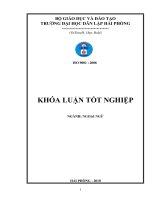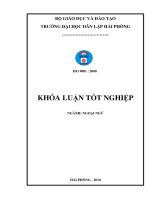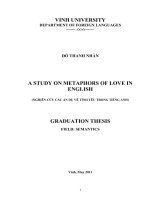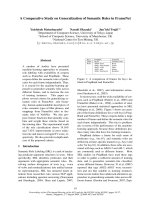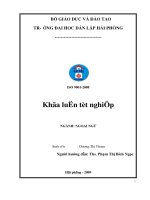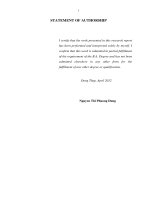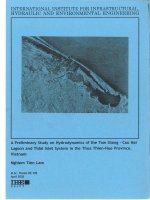A Corpus-based study on collocations of keywords in English business articles about the European debt crisis
Bạn đang xem bản rút gọn của tài liệu. Xem và tải ngay bản đầy đủ của tài liệu tại đây (133.66 KB, 4 trang )
A Corpus-based study on collocations of
keywords in English business articles about the
European debt crisis
Đào Thị Ngọc Nguyên
Trường Đại học Ngoại ngữ
Luận văn Thạc sĩ ngành: English Linguistics; Mã số: 60 22 15
Người hướng dẫn: Ph.D. Phạm Thị Thanh Thùy
Năm bảo vệ: 2012
Abstract. One of the most problematic areas when vocabulary is dealt with is
collocation. It is often seen as arbitrary and overwhelming, a seemingly insurmountable
obstacle to the attainment of native like fluency. This piece of work presents a study on
collocations of keywords within a 20,000-word corpus of various English business
articles about the European debt crisis 2011. The aim of the present study is to find out
high-frequency words used within the corpus, and above all, to examine collocation
patterns of keywords that distinguish the business genre of the selected texts.
Concordance Program 3.3 is the main methods employed throughout the study for the
data collection and analysis. The major findings of the research are a good number of
striking collocation patterns some of the most recurrent keywords possess. The major
findings drawn from the research is the basis for the recommendation of pedagogical
implications and suggestions for raising students' consciousness of the English
collocation acquisition.
Keywords. Ngôn ngữ; Tiếng Anh; Từ vựng
Content
I.1.Statement of the problem and rationale of the study
The importance of vocabulary in language learning has always and long been recognized,
although there were times when vocabulary was treated as separated from grammar and skills.
However, under the light of recent studies, vocabulary has even gained much more attention.
Essential and crucial as it has become, vocabulary has been highlighted as the basis of language
and communication. Wilkins, an outstanding British linguist, once stated "without vocabulary
nothing can be conveyed". Obviously, a rich knowledge of vocabulary not only makes one's
ability of using the language recognized and appreciated but also makes him or her be more
successful in communication.
However, no matter how convinced learners of English in principles of the importance of
vocabulary, the vocabulary acquisition actually poses enormous difficulties to them. One of the
most complicated problems arising when vocabulary is dealt with is how to combine and use
words appropriately in accordance with culture or language conventions, which is often referred
to as “collocation competence” (Hill,1999).
Collocations are usually defined as words that typically occur in association with other words; in
reality, they run through the whole of the English language and they are as old as the language
itself. No piece of natural spoken and written English is totally free of collocations. Because of
their widespread use, the role that collocations play in the language is absolutely undeniable.
For learners of English in general, with collocation competence, they should have the ability to
combine lexical (and grammatical) chunks in order to produce fluent, accurate, as well as
semantically and stylistically appropriate utterances. For business English learners in particular,
a good knowledge of collocation patterns in English is also of great importance. The most
important characteristics of the language of business English, as opposed to the language of
general English, are a sense of purpose, intercultural dimension and a need for clear,
straightforward and concise communication (Ellis & Johnson, 1994). In order to achieve these
broad objectives of business English learners, teachers have to find out the best ways to teach
business performance skills such as socializing, telephoning, meeting, presentation, and report
writing. In all these situations, collocation competence is significantly essential.
With the rise of computing power as well as the acceptance of corpus linguistics since 1990s,
collocations have received serious treatment. The dramatic rise in processing power of
computers now makes it possible to quickly compose lists of frequency for lexical items in a
large corpus. At the same time, there have been a large number of different software programs
installed for keywords and collocations extract from corpus data. Such software packages have
made easier access to the investigation into typical lexical items and their collocations of any
particular text genres.
With the writer’s personal interest in collocations as a researcher and observations of students’
tough experience in dealing with collocations in business discourse as a tutor of business
learners, this thesis provides a comprehensive research on collocations of keywords in a variety
of business articles written about a currently hot topic for business learners, the European debt
crisis. The thesis, therefore, is carried out in the hope that it may be of some help to business
learners of English as well as those who find themselves interested in English semantics and
collocation-related issues.
I.2. Aims of the study
The aim of this research is to conduct a close investigation into collocations of keywords from a
corpus of a certain number of business articles written about the European debt crisis. To be
specific, it identifies words with high frequency of occurrence within the chosen corpus and
examines their collocations. The research, therefore, is carried out to answer the following
research questions:
What are the top high-frequency words in the corpus of written articles about the European
debt crisis?
What are significant patterns and features of collocations of such keywords?
I.3.Scope of the study
This study is about to discuss keywords and their collocations in 15 written articles about the
European debt crisis. The designed corpus of over 20,000 words is taken from online business
articles from websites of high reputation such as The Washington Post, Money CNN,
….Keywords chosen for analysis of significant patterns of collocation within the study are those
which can distinguish the business genre of the selected articles.
I.4. Structure of the thesis
The study is organized as follows:
Chapter I-Introduction- is firstly introduced, briefly stating the rationale, aims, scope and
organization of the study.
Secondly, chapter II-Theoretical Background- deals with the theories setting the
background for the study.
Thirdly, chapter III- Research Methodology- is a presentation on the methodology of the
research, referring to the research design, data collection procedures and data analysis
procedures of the study.
Next, on chapter IV-Results and Discussion-, a detailed discussion of collocations
keywords in the selected corpus is carried out, through which some interesting aspects can
be revealed.
In chapter V-Conclusion- major findings of the study and pedagogical implications and
suggestions are presented.
References
Berber Sardinha, T. (1999).Using Keywords in Text Analysis: Practical Aspects
Biber, D. (1998). Corpus Linguitics : Investigating Language Structure and Use. Cambridge:
Cambridge University Press.
Bowker, L. & Pearson, J. (2002).Working with Specialized Language: A Practical Guide to
Using Corpora.New York: Routledge.
Chitra, Fernando. (1996). Idiom and Idiomacity.Oxford University Press.
Ellis, M. & Johnson, C. (1994). Teaching Business English. Oxford: Oxford University Press
Gains, Ruth & Redman, Stuart. (1986). Working with Words: A Guide toTteaching and Learning
Vocabulary. Cambridge University Press.
Goddard, Cliff. (1996). Semantic Analysis- a Practical Introduction.Oxford University Press.
Halliday, M.A.K. (1966). Lexis as a Linguistic Level.Longman.
Halliday, M.A.K. (1994). An Introduction to Functional Grammar. Arnold.
Hill, J. (1999). Collocational competence. English Teaching Professional, 11, (pp.3-6)
Hoa, Nguyen. (2004). Understanding English Semantics.NXBDHQGHN.
Kearns, Kate. (2000). Semantics. Mac Millian Press Ltd.
Kjellmer, G. (1987). "Aspects of English Collocations", in Meijs, W. (ed) Corpus Linguitics and
Beyond. Rodopi.
Kjellmer, G. (1994). A Dictionary of English Collocations. Clarendon Press.
Kreidler, Charles. W (2001). Introducing English Semantics.London and New York.
Larson, Mildred L. 1984.Meaning-based translation: A guide to cross-language equivalence.
Lanham, MD: University Press of America.
Lyons, John. (1995). Linguistic Semantics-An Introduction.Cambridge University Press.
Meyer, C. (2002). English Corpus Linguistics: An introduction. Cambridge University Press.
McCarthy, M. (1990).Vocabulary.Oxford University Press.
McEnery, T. & Wilson, A. (1996).Corpus Linguistics.Edinburg: Edinburg University Press.
McIntosh, A. (1961). "Patterns and Ranges", in Language, Vol.37 No. 3.
McKeown, Kathleen R. &Radew, Dragomir R. (1999).Collocations.Department of Computer
Science, Columbia University, New York.
Minh Hoang, Do. (2004). Translation Practice.College of Foreign Languages, Vietnam National
University Hanoi.
Mitchell, T.F. (1971). "Linguistic 'going on'.Collocations and other lexical matters arising on the
syntagmatic record", in ArchivumLinguisticum, Vol. II.
Scott, M. (2009).WordSmith Tools 5.0.Oxford: Oxford University Press.
Sinclair, J.M. (1966). Beginning the Study of Lexis. Longman.
Sinclair, J.M (1997) Corpus, concordance, collocation. Oxford: Oxford University Press.
Dictionnaires
Procter, P. et al. (1996). Cambridge International Dictionary of English. Cambridge University
Press.
Rideout, P.M. et al. (1996). The Newbury House Dictionary of American English.Heinle and
Heinle.
Runcie, Moira (2002). Oxford Collocations Dictionary for Students of English.Oxford University
Press.
Oxford Advanced Learner's Dictionary 2011. Oxford University Press.
Oxford Business English Dictionary 2005.Oxford University Press
Collins English Dictionary.Complete and Unabridged.
Longman Dictionary of Contemporary English.Longman University Press.
MacMillan English Dictionary for Advanced Learners. Mac Millian Press Ltd.
Merriam-Webster Online Dictionary
Web documents and sites
Amelia Maria Cava. (2011). A corpus-based approach to research article abstracts.Retrieved
from
Brett Edward Laybutt. (2009). Collocations and textual cohesion: A comparative corpus study
between a genre of Written Sports Reports and a large reference corpus. Retrieved from
Gabrielatos, Constantinos. (1994). Collocations: Pedagogical implications, and their treatment
in pedagogical materials. Retrieved from
John Flowerdew. Concordance in Language Learning.Retrieved from

